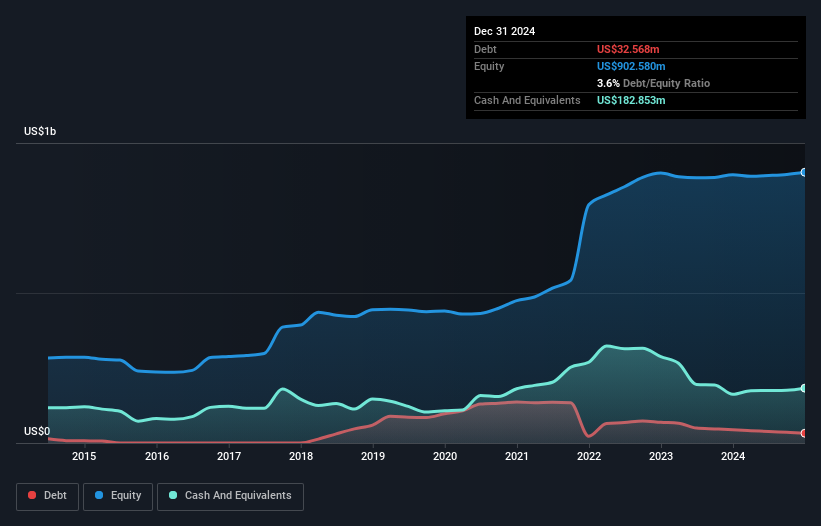
The external fund manager backed by Berkshire Hathaway's Charlie Munger, Li Lu, makes no bones about it when he says 'The biggest investment risk is not the volatility of prices, but whether you will suffer a permanent loss of capital.' It's only natural to consider a company's balance sheet when you examine how risky it is, since debt is often involved when a business collapses. As with many other companies Alpha and Omega Semiconductor Limited (NASDAQ:AOSL) makes use of debt. But the more important question is: how much risk is that debt creating?
What Risk Does Debt Bring?
Debt is a tool to help businesses grow, but if a business is incapable of paying off its lenders, then it exists at their mercy. Ultimately, if the company can't fulfill its legal obligations to repay debt, shareholders could walk away with nothing. However, a more usual (but still expensive) situation is where a company must dilute shareholders at a cheap share price simply to get debt under control. Of course, debt can be an important tool in businesses, particularly capital heavy businesses. When we examine debt levels, we first consider both cash and debt levels, together.
What Is Alpha and Omega Semiconductor's Debt?
You can click the graphic below for the historical numbers, but it shows that Alpha and Omega Semiconductor had US$32.6m of debt in December 2024, down from US$44.1m, one year before. But it also has US$182.9m in cash to offset that, meaning it has US$150.3m net cash.

How Strong Is Alpha and Omega Semiconductor's Balance Sheet?
The latest balance sheet data shows that Alpha and Omega Semiconductor had liabilities of US$151.0m due within a year, and liabilities of US$80.3m falling due after that. Offsetting these obligations, it had cash of US$182.9m as well as receivables valued at US$30.5m due within 12 months. So it has liabilities totalling US$18.0m more than its cash and near-term receivables, combined.
Since publicly traded Alpha and Omega Semiconductor shares are worth a total of US$765.7m, it seems unlikely that this level of liabilities would be a major threat. However, we do think it is worth keeping an eye on its balance sheet strength, as it may change over time. Despite its noteworthy liabilities, Alpha and Omega Semiconductor boasts net cash, so it's fair to say it does not have a heavy debt load! When analysing debt levels, the balance sheet is the obvious place to start. But it is future earnings, more than anything, that will determine Alpha and Omega Semiconductor's ability to maintain a healthy balance sheet going forward. So if you're focused on the future you can check out this free report showing analyst profit forecasts.
See our latest analysis for Alpha and Omega Semiconductor
In the last year Alpha and Omega Semiconductor wasn't profitable at an EBIT level, but managed to grow its revenue by 4.1%, to US$666m. That rate of growth is a bit slow for our taste, but it takes all types to make a world.
So How Risky Is Alpha and Omega Semiconductor?
While Alpha and Omega Semiconductor lost money on an earnings before interest and tax (EBIT) level, it actually generated positive free cash flow US$31m. So although it is loss-making, it doesn't seem to have too much near-term balance sheet risk, keeping in mind the net cash. With revenue growth uninspiring, we'd really need to see some positive EBIT before mustering much enthusiasm for this business. When we look at a riskier company, we like to check how their profits (or losses) are trending over time. Today, we're providing readers this interactive graph showing how Alpha and Omega Semiconductor's profit, revenue, and operating cashflow have changed over the last few years.
If you're interested in investing in businesses that can grow profits without the burden of debt, then check out this free list of growing businesses that have net cash on the balance sheet.
Have feedback on this article? Concerned about the content? Get in touch with us directly. Alternatively, email editorial-team (at) simplywallst.com.
This article by Simply Wall St is general in nature. We provide commentary based on historical data and analyst forecasts only using an unbiased methodology and our articles are not intended to be financial advice. It does not constitute a recommendation to buy or sell any stock, and does not take account of your objectives, or your financial situation. We aim to bring you long-term focused analysis driven by fundamental data. Note that our analysis may not factor in the latest price-sensitive company announcements or qualitative material. Simply Wall St has no position in any stocks mentioned.